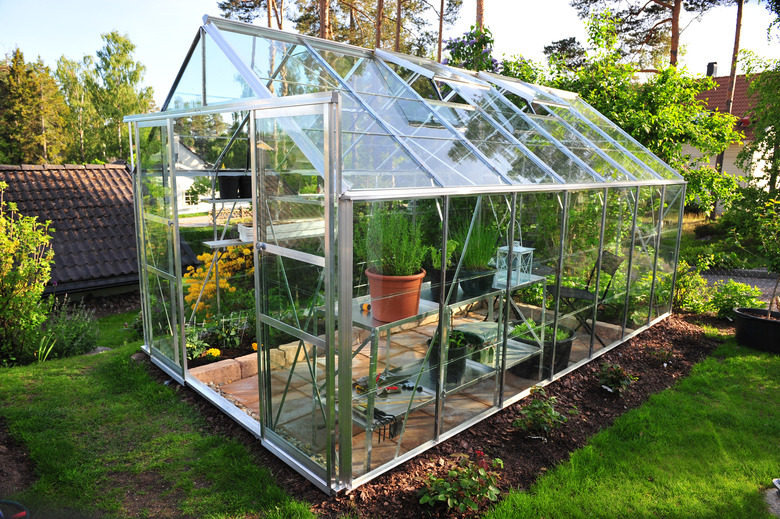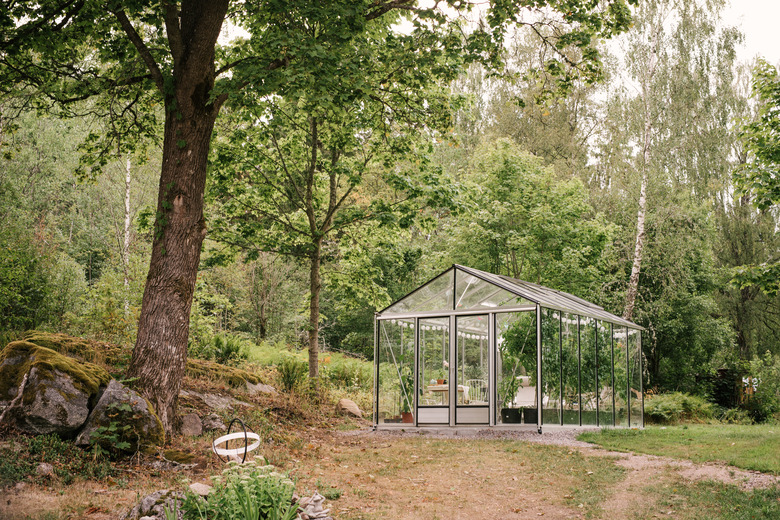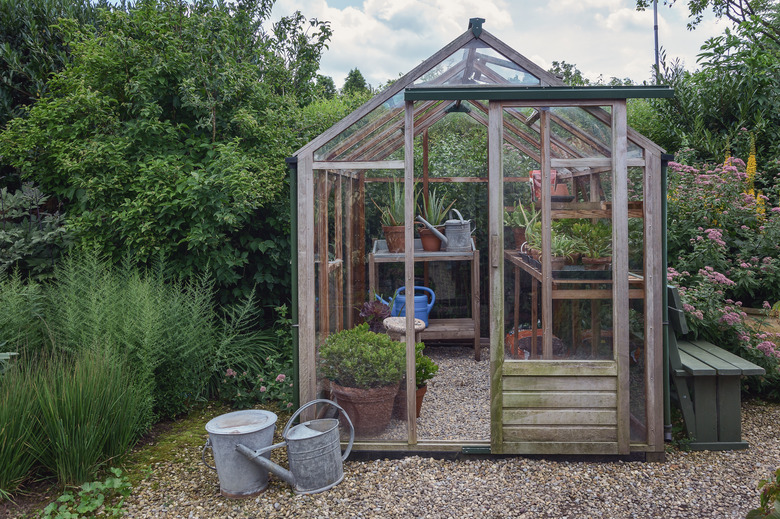Best Greenhouse Glazing, Framing, And Covering Materials
Many avid home gardeners dream of owning their own greenhouse to have out-of-season veggies or a bright splash of colorful flowers available to them year-round. When plotting out a greenhouse in their head, gardeners may conjure up an image of plants beneath a classic glass structure — but there are actually many other greenhouse covering options, including plastics such as polycarbonate panels and polyethylene films.
In very broad terms, greenhouse covering materials can be divided into two categories: plastic films and rigid materials. The films include various thicknesses of polyethylene and polyvinyl chloride (PVC). The rigid types are those made of glass, polycarbonate sheets, fiberglass and a specific type of rigid polyethylene.
Greenhouse Covering Basics
Greenhouse Covering Basics
All of the materials used on greenhouses let in sunlight, but not all materials do it in the same way. Glass, the traditional greenhouse material, lets in direct sunlight. Plastics diffuse the light. Many gardeners believe that direct light is good for starting seeds, but direct light can cause shadows, and it can even burn some plants. Diffuse light is more even light without shadows, providing better growing conditions if raising plants to maturity.
Greenhouse coverings also have some insulating ability to keep as much heat as possible from escaping. The combination of capturing sunlight and holding heat helps provide the conditions to grow plants in the off season, experiment with new varieties and even develop custom potting soil mixes.
While all common greenhouse materials do basically the same thing in terms of capturing sunlight and holding in heat, there are other factors to consider. The materials vary in their ability to withstand wind and heavy snow loads. Some have more durability than others at withstanding daily wear and tear.
Plastic-Film Greenhouses
Plastic-Film Greenhouses
Polyethylene is the most commonly used plastic film for greenhouses. As a glazing, the material lets in about 80 to 90 percent of the sunlight that strikes it, providing diffuse rather than direct light. Many manufacturers use double or triple layers of the material to increase its strength and beef up its insulating ability. A double-layer sheet can get close to an R-2 (a measurement on a scale of insulating ability), which is comparable to double-pane glass.
For the home gardener, polyethylene is used for small plant-growing structures designed for patios, decks and terraces that are only a few feet wide and arm's length deep with more reach-in growing areas than traditional greenhouses. Larger plastic-film greenhouses go up quickly and can usually be moved easily if necessary. Some are designed to be placed directly over a planting area to provide protection for in-ground plants.
Polyethylene greenhouse kits often have roll-up doors and windows. Stability against the wind is provided by anchoring devices, such as stakes driven into the ground around the base of the unit. There are some models that are staked into the ground like tents.
Sunlight breaks down most plastics, so those used on greenhouses are usually treated with a UV inhibitor. Still, expect a polyethylene-film greenhouse to last three or four years. The material is also prone to punctures and may sag under a heavy snow load.
PVC film is also used as a greenhouse covering. PVC greenhouses are similar to those covered with polyethylene, but the material usually costs more. Good-quality PVC will typically last longer than polyethylene.
Glass-Covered Greenhouses
Glass-Covered Greenhouses
All greenhouse glazing materials are compared to glass — it is the original glazing, and it is still the image most people have when they think about greenhouses. Manufacturers of glass greenhouses use tempered glass for its strength, impact resistance and the way it resists scratching, making it one of the best materials to cover your plants during the winter. A glass greenhouse can last up to 25 years.
Greenhouses come with single-pane or double-pane glass. A double-pane unit provides about an R-2 of insulating ability. Glass treated with low-emissivity coatings gets up to an R-3.5 or 4. Low-e coatings are usually an option and not standard for most greenhouse kits.
Glass greenhouse kits come with metal or wood framing. They are usually constructed on concrete slabs, patio pavers or a gravel base. Better-quality kits come with hinged doors and windows. Glass greenhouses are usually the most expensive option.
A clear glass covering means that the greenhouse's contents are in full view. Many of the other materials used are translucent rather than crystal clear.
Rigid-Plastic Greenhouses
Rigid-Plastic Greenhouses
Polycarbonate panels are the most popular rigid glazing materials used on homeowner, or hobby, greenhouses. Most manufacturers of polycarbonate greenhouses use two, three or even five layers of UV-treated plastic that include separators between the panels. This creates air-filled chambers between the layers, which ups the insulation value of the assembly. A triple- or five-layer panel that is 16 millimeters thick, which is about as thick as they get, can have an R-2.5 or higher.
The panels are lighter than glass, so they are easier to ship and install. The best greenhouse kits look like traditional glass greenhouses, with operable doors and windows. Multilayer panels are not crystal clear, but they do provide diffuse light.
Polycarbonate can scratch, and the life expectancy is about 10 to 15 years. The kits can be installed on a slab foundation or a gravel base. Check with the local building department about foundation requirements.
Another plastic, twin-wall polyethylene, is more rigid than polyethylene film and more flexible than polycarbonate panels. The material is available in panels and rolls as well as twin-wall polyethylene greenhouse kits. The material is similar to other poly panels, and it boasts insulating ability up to R-2.3. The material is milky white in appearance but provides excellent light diffusion.
Fiberglass was one of the first materials to challenge glass. Today, it is a small part of the residential hobby-greenhouse market. One advantage it has over other kits is that some fiberglass greenhouses do not require assembly and are delivered in one piece.
Greenhouse Framing Materials
Greenhouse Framing Materials
Greenhouses can be framed with steel, aluminum, plastic or wood. Tubular steel has the advantage of not presenting much of a profile, so it does not block a lot of light, yet it is strong and long lasting. For hobby greenhouses, a steel skeleton is usually covered with a plastic film.
Plastic, usually tubular PVC, is used for the framing of small, portable greenhouses. It is not as strong as metal, but many manufacturers combine plastic frames with metal components to increase the unit's strength. It is also less expensive than the other materials, and it does not conduct heat as much as aluminum or steel.
Large, permanent greenhouses often have aluminum frames. The material is strong and can be coated in different colors. Aluminum framing is thin enough to allow in the maximum amount of light but still support greenhouse walls and ceilings. Aluminum components are manufactured with channels that accept glass and polycarbonate panels. It can add to the cost of the greenhouse kit, but it will outlast most other framing materials.
Wood is often the choice for custom greenhouse designs, but it is also available for kits as well. The framing components are usually larger than those found on a metal-framed greenhouse. The appearance of a wood greenhouse often compensates for the lost glazing area. Cedar and redwood are popular choices for wood greenhouses. They look good, and they can stand up to the elements and to insects.


